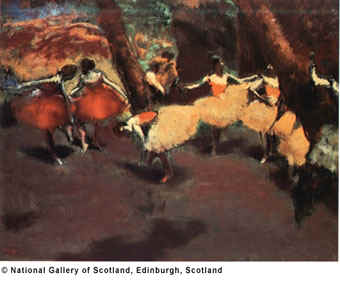
Lesson #9
Edgar Degas (duh-GAH)
French, 1834-1917
Before the Performance, about 1896-98
Oil on paper laid on canvas
18 3/4 x 24 3/4 in.
© National Gallery of Scotland, Edinburgh, Scotland
Subject
Before the Performance depicts a favorite Degas subject, an off-guard moment in the life of the Paris ballet dancer. As the last minutes to curtain time tick by, these little "rats" (a common nickname for the company's adolescent dancers) daydream, gossip, and adjust their costumes. By the 1890s, Degas had little need to sell his work, thanks to earlier commercial success and inherited wealth. He was able to take more risks artistically, as demonstrated in the moodiness of this painting. Notice how the dancers' faces are blank and expressionless; they stand to the rear of the picture space, as if alienated from the viewer. The artist no longer tried to render his subjects' feelings. "They call me the painter of dancers," Degas said, "without understanding that for me the dancer has been the pretext for painting beautiful fabrics and rendering movement."
Style
The artist was fascinated by the succession of movements and gestures - one reason, no doubt, that he painted dancers in so many positions. He liked the artistic tension of arms and legs straining and twisting at odd angles, apparent in the two dancers on the right of this painting. The figure bisected by the picture frame (left) and the slash of trees across the background show the influence of photography on Degas' compositions.
Some photographs capture unusual, spontaneous compositions with figures, and objects cropped off rather than whole within the image. Blurred edges and delicate application of paint give the painting a two-dimensional, decorative feeling reminiscent of the Japanese prints so popular at the time. Degas also used more brilliant, expressive colors than in earlier works. The orange tutus are a soft smudge of paint, resembling the original pastel that inspired this painting.
Artist
Edgar Degas was born to an affluent Parisian banking family and briefly studied law before turning to art. Although a founding member of the Impressionist group exhibitions, Degas never really thought of himself as an Impressionist.
He had received academic art training. He worked more realistically than the other Impressionists for much of his career. His drawing skills, obvious in the clear, deliberate lines around his painting subjects, also set him apart from Monet, Renoir, Sisley, and many others. Unlike his fellow Impressionists, who were criticized for sloppy brushwork and lack of finish, Degas was sometimes questioned for the "low-life" subjects he painted obsessively: laundresses, dancers, and street women. In later life, the artist moved away from realism toward a looser style that would inspire a new generation of painters. This looser style was due, in part, to his failing eyesight.
Looking Questions
- Squint your eyes and describe the colors, shapes, and patterns that you see.
- Where is the source of light?
- Name the colors that are repeated.
- What complementary colors do you see?
- What did the artist crop or cut off at the edges of this painting?
- Cover the bottom third of the transparency. How does it change?
- Cover all of the transparency except one of the dancers. What did the artist choose to simplify or eliminate?
- Imagine that all the dancers were wearing pink instead of yellow and orange. How would it change the mood of the painting?
Activities
The Arts
Look at all the different positions the dancers' bodies take in the painting. Recruit a few willing students to pose in the same positions the dancers took while the artist, Edgar Degas, sketched, photographed, or painted them. The rest of the students will sketch a series of quick drawings capturing the movement and gesture of the body rather than making it anatomically correct. Use charcoal crayons or soft pencils for this exercise.
Math or Science
One influence on Impressionist painting was the invention of the camera in the middle of the 19th century.
There was no longer a need to paint a person or event with complete accuracy because a photograph could be taken instead. The computer was invented in the middle of the 20th century. What new kinds of art has the computer influenced or enabled? Ask the students to write an essay about these two inventions and their impact on the world of art.
Language Arts
Have the students compose a story describing the movements of the dancers in the painting. List words that describe the dancers' actions. What happened after the moment you see in the image? The title of the painting is Before the Performance. Have the students write what they imagine the performance would be like.
Social Studies
This painting has several colors, like buttery yellows and peachy oranges. Write a recipe for this painting. Include measurements, all the ingredients you can find, the time to prepare, and any special "cooking" or "viewing/consuming" instructions. Write another recipe for one of the other transparencies (maybe the other Degas) and see if someone else can guess which recipe matches each image. For example: "You will need orange, yellow, brown, black, white, and green paint. Mix paint to taste. Apply paint liberally to background, foreground, and dancers' costumes and sparingly to bodies and faces. Sprinkle white paint to garnish. Enjoy this satisfying painting again and again!"
Visit our Impressionism Glossary page, click here.
